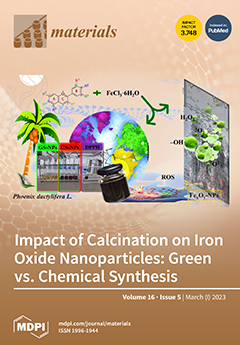In this paper, micron-sized TiB
2/AlZnMgCu(Sc,Zr) composites were fabricated by selective laser melting (SLM) using directly mixed powder. Nearly fully dense (over 99.5%) and crack-free SLM-fabricated TiB
2/AlZnMgCu(Sc,Zr) composite samples were obtained and its microstructure and mechanical properties were investigated. It
[...] Read more.
In this paper, micron-sized TiB
2/AlZnMgCu(Sc,Zr) composites were fabricated by selective laser melting (SLM) using directly mixed powder. Nearly fully dense (over 99.5%) and crack-free SLM-fabricated TiB
2/AlZnMgCu(Sc,Zr) composite samples were obtained and its microstructure and mechanical properties were investigated. It is found that the laser absorption rate of powder is improved by introducing micron-sizedTiB
2 particles, then the energy density required for SLM forming can be reduced, and the densification can finally be improved. Some crystalline TiB
2 formed a coherent relationship with the matrix, while some broken TiB
2 particles did not, however, MgZn
2 and Al
3(Sc,Zr) can perform as intermediate phases to connect these non-coherent surfaces to aluminum matrix. All these factors lead to an increase in strength of the composite. The SLM-fabricated micron-sized TiB
2/AlZnMgCu(Sc,Zr) composite finally shows a very high ultimate tensile strength of ~646 MPa and yield strength of ~623 MPa, which are higher than many other aluminum composites fabricated by SLM, while maintaining a relatively good ductility of ~4.5%. The fracture of TiB
2/AlZnMgCu(Sc,Zr) composite is occurred along the TiB
2 particles and the bottom of the molten pool. This is due to the concentration of stress from the sharp tip of TiB
2 particles and the coarse precipitated phase at the bottom of the molten pool. The results show that TiB
2 plays a positive role in AlZnMgCu alloys fabricated by SLM, but finer TiB
2 particles should be studied.
Full article






